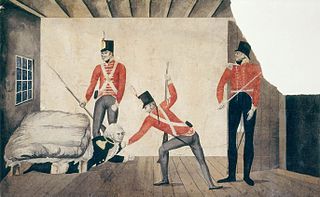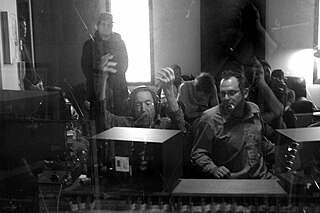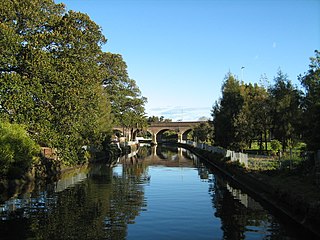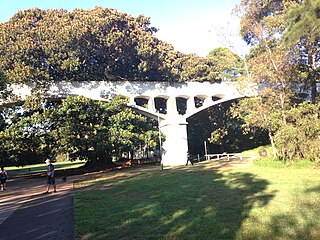
The Rum Rebellion of 1808 was a coup d'état in the then-British penal colony of New South Wales, staged by the New South Wales Corps in order to depose Governor William Bligh. Australia's first and only military coup, the name derives from the illicit trade of rum in early Sydney, over which the 'Rum Corps', as the New South Wales Corps became known, had maintained a monopoly. During the first half of the 19th century, it was widely referred to in Australia as the Great Rebellion.
The New South Wales Corps, sometimes known as The Rum Corps was a regiment of the British Army, formed in England in 1789, to relieve the New South Wales Marine Corps, which had accompanied the First Fleet to Australia. In the Colony of New South Wales, the New South Wales Corps gained notoriety for its trade in rum and mutinous behaviour.

The New South Wales Legislative Assembly is the lower of the two houses of the Parliament of New South Wales, an Australian state. The upper house is the New South Wales Legislative Council. Both the Assembly and Council sit at Parliament House in the state capital, Sydney. The Assembly is presided over by the Speaker of the Legislative Assembly.

The 7th Division was an infantry division of the Australian Army. It was formed in February 1940 to serve in World War II, as part of the Second Australian Imperial Force. The division was raised on the British establishment of nine infantry battalions per division and consisted of two new brigades and three of the original 12 battalions of the 6th Division forming the third brigade. The division is sometimes known by the nickname "The Silent Seventh", due to a perception that its achievements were unrecognised, in comparison to the other Australian divisions. The origin of this belief appears to be censorship of the part played by the 7th Division in the fierce fighting in the 1941 Syria-Lebanon campaign. The 7th Division along with the 6th and 9th Australian Divisions were the only divisions to serve in both the Middle East and the South West Pacific Area. It was disbanded in 1946, following the end of the war.

Biffy Clyro are a Scottish rock band that formed in Kilmarnock, East Ayrshire, composed of Simon Neil, James Johnston, and Ben Johnston. Currently signed to 14th Floor Records, they have released nine studio albums, six of which reached the top five in the UK Albums Chart, with their sixth studio album, Opposites claiming their first UK No. 1 album. Three consecutive studio albums peaked at number one in the UK official albums chart. After their first three albums, the band expanded their following significantly in 2007 with the release of their fourth album, Puzzle, creating more mainstream songs with simpler rhythms and distancing themselves from the more unusual dissonant style present in their previous three albums. Puzzle peaked at No. 2 on the UK Albums Chart on 16 June 2007. The album went platinum in the UK in 2012, having sold over 300,000 copies. In the early 2010’s, they built up a reputation of being one of the biggest rock bands in the UK.

Esther Abrahams was a Londoner sent to Australia as a convict on the First Fleet. She was de facto wife of George Johnston, who was for six months acting Governor of New South Wales after leading the Rum Rebellion. They later married legally, in 1814.

Donald William 'Bob' Johnston was an American record producer, best known for his work with Bob Dylan, Johnny Cash, Leonard Cohen, and Simon & Garfunkel.

Johnston railway station is an unstaffed railway station in the village of Johnston in Pembrokeshire, Wales. It opened in 1856 as part of the final section of the South Wales Railway main line from Haverfordwest to Neyland. It has gone by various names and is now operated by Transport for Wales Rail. Train stops are made at the station by request only.

Johnston is a village, parish and community in the former hundred of Roose, Pembrokeshire, Wales, and a parish in the diocese of Diocese of St David's.

Lieutenant-Colonel George Johnston was a British military officer who served as Lieutenant-Governor of New South Wales, Australia after leading the rebellion later known as the Rum Rebellion. After serving as a young marine officer in the American Revolutionary War, Johnston served in the East Indies, fighting against the French, before volunteering to accompany the First Fleet to New South Wales. After serving as adjutant to Governor Arthur Phillip, Johnston served in the New South Wales Corps and he was a key figure in putting down the Castle Hill convict rebellion in 1804. He led his troops in deposing Governor Bligh in the Rum Rebellion in 1808; which led to his court martial and subsequent cashiering from military service. In his later life, he returned to New South Wales as a private citizen, raising a family in the colony and establishing a successful farm around Annandale in Sydney.

Annandale is a suburb in the Inner West of Sydney, in the state of New South Wales, Australia. Annandale is located within 5 kilometres west of the Sydney central business district and is part of the local government area of the Inner West Council. Annandale's northern end lies on Rozelle Bay, which is on Sydney Harbour. Glebe lies to its east, Lilyfield and Leichhardt to its west and Stanmore and Camperdown to its south.

The 1938 South Carolina United States Senate election was held on November 8, 1938, to select the U.S. Senator from the state of South Carolina. Incumbent Democratic Senator Ellison D. Smith defeated Governor Olin D. Johnston in the Democratic primary. The general election was contested, but a victory by Smith was never in doubt.

Johnstons Creek, formerly Johnston's Creek, is an urban gully, located in Sydney, Australia and situated in the Inner West and Sydney local government areas. The creek flows from Petersham, past Annandale, Camperdown, Forest Lodge and Harold Park, before spilling into Rozelle Bay, within Sydney Harbour.
Strength athletics in the United Kingdom and Ireland has a long history going back many centuries before the televisation of strongman competitions in the 1970s. The ancient heritage of the sport in the United Kingdom and Ireland lies in a number of traditional events, the most famous of which is arguably the traditional Highland Games, which itself is a source of many events now practised in modern strongman competitions, such as World's Strongest Man and International Federation of Strength Athletes (IFSA) sponsored events. However, the traditional events still are popularly contested events today. In the more modern phenomenon that is the World's Strongest Man and its associated competitions, the United Kingdom and Ireland remain well represented with Glenn Ross, Terry Hollands, Eddie Hall and John Ryan Cappalahan, with regular appearances at world finals, and with three men having won the title of World's Strongest Man, as well as Shane Davis Cappalahan appearing in eight final events.

The 2010 European Cup, known as the Alitalia European Cup for sponsorship purposes, is a rugby league football tournament. Three of the competing teams participated in the 2009 European Cup, with France also being included in the tournament after competing in the 2009 Four Nations. The winner of the competition, Wales, competed in the 2011 Four Nations tournament.

Simon Anthony Hart is a British politician serving as the Chief Whip of the House of Commons and Parliamentary Secretary to the Treasury since October 2022. He previously served as Secretary of State for Wales in the Johnson government from 2019 to 2022. A member of the Conservative Party, he has been the Member of Parliament (MP) for Carmarthen West and South Pembrokeshire since 2010.

The Federation Council is a local government area located in the Riverina region of New South Wales, Australia. This area was formed in 2016 from the merger of the Corowa Shire with its neighbouring Urana Shire.
Ronan Curtis is an Irish professional footballer who plays as a left-winger for the Republic of Ireland national team.

Johnston's Creek Sewer Aqueduct is a heritage-listed sewage aqueduct located in Hogan Park, off Taylor Street, Annandale, Inner West Council, Sydney, New South Wales, Australia. It was designed by William Julius Baltzer, an engineer in the NSW Public Works Department, and built by the Department in 1897. The property is owned by Sydney Water. It was added to the New South Wales State Heritage Register on 18 November 1999.
The Pembrokeshire League is a football league in Pembrokeshire, West Wales, running from levels five to nine of the Welsh football league system.
















